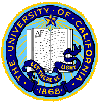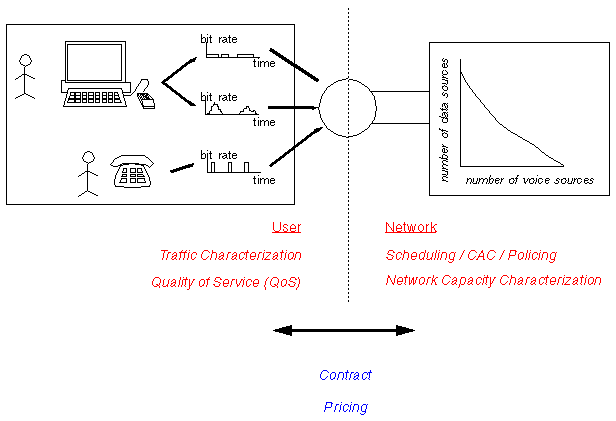 |
Scott Jordan | |
|
|
 Our focus in this work is on dynamic pricing of network resources. The work is characterized by four aspects:
Our focus in this work is on dynamic pricing of network resources. The work is characterized by four aspects:
- Pricing is dynamic, on a time scale that is slower than congestion control but quicker than connection access control.
- Resources are allocated to users in a fashion that maximizes social welfare. Prices are used to signal the marginal utility of each network resource.
- The network is assumed to support integrated services, and resource prices are often translated into QoS prices to efficiently support a diverse range of applications.
- Users are assumed to be cooperative, not game-playing. Cooperation may be induced through charges to users.
Our goal is use network pricing to connect traffic characterization, scheduling, and connection access control. There is now a substantial body of work on traffic characterization and application requirements characterization, which will allow users to describe the QoS requirements of their traffic flows. There is also a substantial body of work on integrated and differentiated services network architectures, which will allow networks to give differentiated performance to these flows.
However, without some policy to manage QoS within the network, the network can not efficiently transform such user characterizations into network resource allocations and make intelligent decisions as to how to treat each traffic flow.
The following papers are some of the earliest work in the field of pricing of network resources. They assume the network has an architecture that allows for reservation of network resources, e.g. Internet's IntServ or ATM's virtual paths. Real-time services measure utility by the loss experienced on the network path, while non real-time services measure utility by the time required to transmit a file. Prices are set per unit effective bandwidth on each network link, so that each application can determine the QoS it should receive.
Connection Establishment in High Speed Networks (with H. Jiang), IEEE Journal on Selected Areas in Communications, vol. 13 no. 7, September 1995, pp. 1150-1161.
The Role of Price in the Connection Establishment Process (with H. Jiang), European Transactions on Telecommunications, vol. 6 no. 4, July-August 1995, pp. 421-429.
A Pricing Model for High Speed Networks with Guaranteed Quality of Service (with H. Jiang), IEEE InfoCom, March 1996, pp. 888-895.
The next set of papers expands this framework to associate prices with both bandwidth and buffer. Real-time services measure utility by the combination of end-to-end loss and delay, and they request the combination of bandwidth and buffer that most efficiently achieves their desired loss and delay.
The Effect of Bandwidth and Buffer Pricing on Resource Allocation and QoS (with N. Jin), Computer Networks, Special Issue on Internet Economics: Pricing and Policies, vol. 46 no. 1, September 2004, pp. 53-71.
Dynamic Congestion-Based Pricing of Bandwidth and Buffer (with N. Jin and G. Venkitachalam), IEEE/ACM Transactions on Networking, vol. 13 no. 6, December 2005, pp. 1233-1246.
The final set of papers considers an architecture that allows for prioritization (rather than reservation), e.g. Internet's diffServ. The premise is that network pricing may be able to decide what priority each packet should receive, i.e. how to assign codepoints. Prices are associated with each codepoint, and users choose traffic rates on each codepoint on the basis of price and QoS.
On the Feasibility of Dynamic Congestion-Based Pricing in Differentiated Services Networks, IEEE/ACM Transactions on Networking, vol. 16 no. 5, October 2008, pp. 1001-1014.
A Pricing Model for Networks with Priorities (with H. Jiang and I. Sidhu), Allerton Conference on Communication, Control and Computing, September 1996, pp. 269-275.
Portions of this work were supported by DARPA and NSF. Any opinions, findings, conclusions or recommendations expressed in this material are those of the author(s) and do not necessarily reflect the views of the National Science Foundation, DARPA, or IEEE. This material is presented to ensure timely dissemination of scholarly and technical work. Copyright and all rights therein are retained by authors or by other copyright holders. All persons copying this information are expected to adhere to the terms and constraints invoked by each author's copyright. One print or electronic copy may be made for personal use only. Permission must be obtained from the copyright holder for systematic or multiple reproduction, distribution to multiple locations via electronic or other means, duplication of any material in these papers for a fee or for commercial purposes, modification of the content of these papers, reprinting or republishing of this material for advertising or promotional purposes or for creating new collective works for resale or redistribution to servers or lists, and to reuse any copyrighted component of this work in other works.